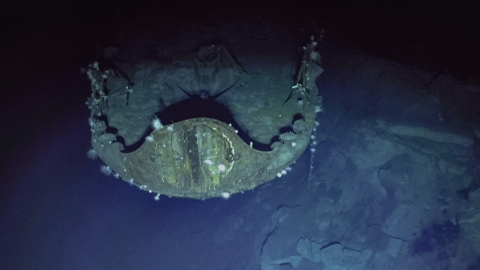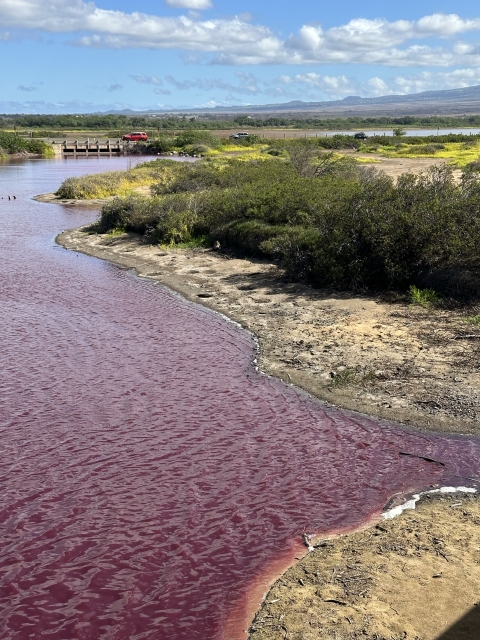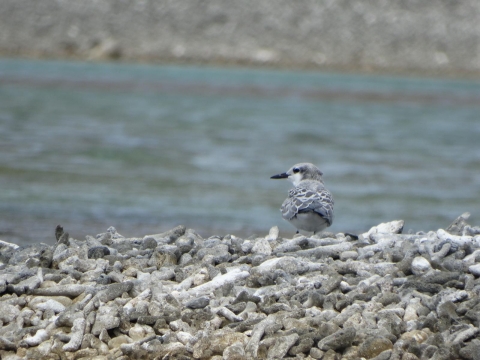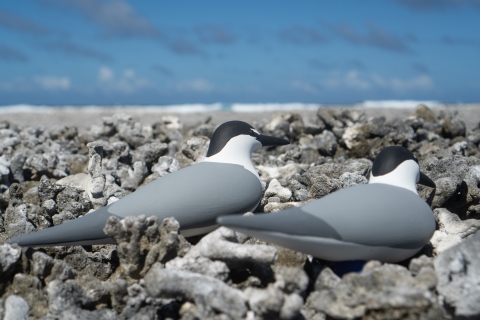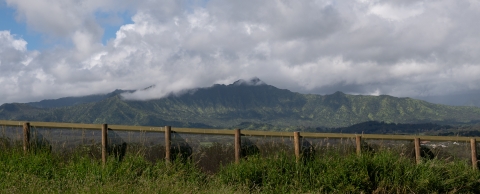The national wildlife refuges and marine national monuments of the Pacific Islands are among the most captivating natural wonders on the planet. Each year numerous discoveries are brought to light in the realm of their ecology, geology, and cultural history, and the compelling conservation efforts continue to interest of people from across the globe.
In the Pacific Islands alone, the U.S. Fish and Wildlife Service has management and regulatory responsibilities for an area larger than the continental United States. This includes refuges and monuments within the Commonwealth of the Northern Mariana Islands, Guam, American Samoa, and Hawaiʻi. Throughout the Pacific Islands the Service manages four Marine National Monuments and 22 National Wildlife Refuges covering over 750 million acres. It is an area with a diverse set of ecosystems ranging from the depths of the Mariana Trench to the top of Mauna Kea, and from coral reefs to streams, rainforests, and alpine deserts. These special places protect endangered and threatened species, as well as some of the best remaining wildlife habitat in the Pacific, as well as significant cultural and historical resources.
During 2023, some of these national treasures were highlighted by spectacular discoveries, vibrant and magnificent wonders, and conservation efforts that are demonstrative of successful partner collaborations. The wonders and discoveries of wildlife have long served as a profound source of inspiration for humanity. The intricate beauty and diversity found in the natural world of the Pacific Islands continue to captivate our imagination and ignite a sense of awe.
These six events from 2023 brought much attention from across the world.
Three Battle of Midway iconic shipwrecks surveyed near Midway Atoll
During September , Ocean Exploration Trust led an expedition to an unexplored northwestern section of Papahānaumokuākea Marine National Monument aboard E/V Nautilus using remotely operated vehicle and seafloor mapping operations. While the expedition's main focus was the geology and biology of unexplored seamounts, the operating area included several historically significant shipwrecks associated with the World War II Battle of Midway.
A total of three World War II aircraft carriers lost during the Battle of Midway were surveyed by the Exploration Vessel Nautilus from Sept. 8-12, 2023. The exploration resulted in the first visual survey of Imperial Japanese Navy (IJN) Akagi 赤城, the first detailed views of U.S. Yorktown since it was first located over two decades ago, and a comprehensive survey of IJN Kaga 加賀. These historically significant wrecks were explored in their final resting places within Papahānaumokuākea Marine National Monument, the largest protected area in the U.S. and one of the largest in the world.
Over 100 experts from the U.S., Japan, and across the globe were connected to ship operations via video to help guide the mission while providing valuable real-time interpretations throughout the surveys. Over 14 hours were spent surveying just the carrier Akagi. This was the first time the vessel had been seen since sinking during June 1942's Battle of Midway. The vessel was initially located during a mapping survey in 2019. The Yorktown was first located 25 years ago during a joint U.S. Navy and National Geographic Society expedition led by Robert Ballard, the founder of Ocean Exploration Trust.
The expedition team completed non-invasive visual surveys of the wrecks during three deployments below 5,100 meters. The mission marked the deepest, remotely operated vehicle dive that the E/V Nautilus has ever completed. For over 43 hours at depth, the team methodically circumnavigated these historic wrecks, bringing to light many features in great detail, including their armament, battle, and sinking-related damage.
Much global attention was brought to the remote Papahānaumokuākea Marine National Monument during these exciting deep-sea discoveries, twice in a single month. The dives were launched and closed with protocol ceremonies to honor the location and all who lost their lives in ways that reflected their significance to Native Hawaiian, U.S. military and Japanese, families and communities.
These historic dives were conducted as part of the Nautilus Ala ʻAumoana Kai Uli (Path of the Deep Sea Traveler) expedition, a 27-day mission funded by National Oceanic and Atmospheric Administration and permitted by the U.S. Fish and Wildlife Service.
Humanity still knows very little about what lies in the deep waters of the vast ocean. Deep-sea explorations continue to bring to light how many extraordinary things are still undiscovered in the great depths of our ocean.
Maui Island’s Keālia Pond bright pink waters marvel the world
A strange ecological occurrence at Keālia Pond National Wildlife Refuge was a marvel for thousands of visitors and millions of people globally, who came across the news of the magenta-colored, water phenomenon during the late fall and winter season. In late October, a single-celled organism called Thiohalocapsa, a salt-loving organism found in high salinity water bodies, turned the waters at Keālia Pond a vibrant, magenta color.
According to preliminary analyses from University of Hawaiʻi at Mānoa and George Washington University, more than 50% of the microbes in the water samples taken from the refuge’s pink waters belonged to this bacterial genus, which is part of a larger group known as the purple sulfur bacteria. At the time when the magenta color first appeared, the drought conditions had driven water levels to be very low, and salinity was measured as greater than 70 parts per thousand (twice the salinity of seawater). Purple sulfur bacteria are commonly found in anoxic wetlands and other habitats depleted of dissolved oxygen. They usually perform anoxygenic photosynthesis, meaning oxygen is not produced during photosynthesis. This contrasts with photosynthesis in plants, which does produce oxygen.
Although the purple sulfur bacteria at Keālia Pond is a pink magenta color, purple sulfur bacteria are not always this color. A combination of pigments called carotenoids and bacteriochlorophylls, with which they harvest light, may color them brown, orange, red, or as in the case of Keālia Pond NWR – magenta. Bacteriochlorophylls are not the same as chlorophyll used in plants. Purple sulfur bacteria are crucial in nutrient cycling in the environment, particularly in the sulfur cycle. They can help reduce environmentally harmful compounds and odor emissions that can build up in anoxic water.
Refuge staff are not exactly sure why the bacteria bloom at the Keālia Coastal Boardwalk is so intense and vibrant. People are welcome to visit the refuge and enjoy this natural phenomenon while it lasts. As a precaution, the refuge recommends that people keep a safe distance from the water, not enter the water, don’t consume any fish from the water, and ensure that pets don’t drink the water. Increased visitation to view the pink water resulted in approximately 11,000 visitors to the boardwalk over Veteran’s Day Weekend.
The rare occurrence is a good reminder that our refuges are vital places for threatened and endangered species, though also are places where we can connect and engage community with science -- including the discovery of purple sulfur bacteria. Our refuges are places to enjoy the splendor of nature as it has been with the illuminating lesser known, purple sulfur bacteria at Keālia Pond and learning how their ecological functions are important and memorable.
Gray backs are back at Palmyra!
It had been decades since the last time a gray back tern was seen at Palmyra Atoll National Wildlife Refuge, within the Pacific Remote Islands Marine National Monument. To attract seabirds to their traditional nesting areas at Palmyra Atoll NWR, scientists from the Nature Conservancy began deploying social attraction techniques in 2020, including wooden seabird decoys mimicking colonies and “seabird discotheques” that play the calls of the eight absent seabirds 24/7. This social attraction system did more than just attract gray back terns. To the surprise of scientists at Palmyra (and beyond) a gray back tern chick was found at North Barren Island near the social attraction system. This little chick will hopefully be the first of many gray back terns to officially claim Palmyra as their home.
The April 1st discovery is an important milestone for Palmyra and the conservation efforts that have been in motion for almost two decades. This bird is one of eight seabird species that is known to the region, but has been conspicuously absent from the atoll, likely due to invasive rats that were introduced during the World War II era. Since rats were eradicated in 2011, recolonization by seabirds is what conservationists at Palmyra have been working toward.
The social attraction system utilizes sound that mimic colonies. Some call them “seabird discotheques.” These discotheques play calls day and night of the eight species of seabirds that have been absent at Palmyra for many years, including grayback terns.
Grey-backed terns, or pākalakala in Hawaiian, are found in Hawai‘i as well as other remote islands across the Pacific. While they are not endangered, they are especially vulnerable to invasive predators as they lay a single egg per season. Approximately 30% of seabirds are endangered, making them one of the most threatened bird groups on the planet.
The Nature Conservancy works with the Service to enhance Palmyra’s seabird habitat and maintain social attraction sites across the atoll to encourage seabirds extirpated from the atoll to come home and settle down. The Service and conservation partners are hopeful the gray backs' return will mark a pivotal turning point where other endangered seabirds will follow suit and return to Palmyra.
Seabirds play a vital role in island ecosystems, since their guano provides nutrients for plants and trees on land, while such vegetation combats runoff, soil erosion and directly increases the health and resilience of coral reefs and fish populations. Providing safe havens that are predator-free, such as Palmyra Atoll or areas with predator-proof fencing, gives these birds a chance to thrive.
Short-tailed albatross family reunion on Midway
With a wingspan of over seven feet, makalena (short-tailed albatross) is the largest seabird in the North Pacific. Their gorgeous feathers and approachability while nesting led partly to their demise as tens of thousands were slaughtered for their feathers for use on women's hats. From a historic population of millions to less than 10,000 today, the short-tailed albatross is one of the most rare and endangered seabirds in the North Pacific. Previously, the short-tailed albatross range spanned across the Pacific from Japan to Alaska to Hawaiʻi. Today, most of their breeding activity is confined to two colonies in the Senkaku Islands and Izu Islands, northwest of Taiwan.
Outside of remote Torishima Island in Japan and the Senkaku Islands, the only known nesting pair successfully hatching chicks resides within Papahānaumokuākea Marine National Monument at Midway Atoll National Wildlife Refuge.
George and Geraldine, the sole pair of short-tailed albatrosses breeding on Midway Atoll, hatched and fledged another chick in 2023. The pair has hatched and fledged four birds since their first known meeting back in 2016. And an even bigger surprise at Midway included a makalena family reunion in 2023. By the middle of January, six makalena were found on Midway in 2023. It included George, Geraldine, and chicks from 2023, 2021, 2020 and 2019.
George and Geraldine returned to Midway in mid-October 2023 and laid another egg, which hatched late December, 2023. If all goes as smooth as it has for the past six years, the Midway short-tailed albatross family could reach seven happy makalena in 2024.
The longest predator-proof fence in the nation
To help protect tens of thousands of Hawai‘i’s migratory and native birds from non-native predators such as feral cats and pigs, the Kīlauea Point NWR predator exclusion fence was built in 2023. The fence spans 2.1 miles, enclosing 168 of the refuge’s 199 acres, making it the longest predator-proof fence in the nation. The Kīlauea Point NWR is already home to some of the largest breeding colonies of seabirds within the main Hawaiian Islands.
Predator exclusion fences are used to create protected areas that are free of predator species, and they are primarily used on islands where destructive mammalian predators have been introduced. The fences were developed in New Zealand and have been used in Hawaiʻi since 2011, and their use has been recently expanded to Australia and Mexico.
Unfortunately, even with long term predator removal programs in place, invasive predators have intermittently decimated nesting seabirds on the refuge. About 70 albatross nests were lost this season alone prior to completion of fence construction. The completed predator exclusion fence now prevents these animals from entering the refuge and thus provides protection for the tens of thousands of nesting birds.
Kauaʻi has the highest number of ground-nesting seabird species in the state, and the Service has utilized resources and partnerships to promote opportunities to protect these species. The construction of the predator-proof fence is one of the best examples of such partnership opportunities.
These specialized barriers incorporate buried skirts, tight mesh walls and hoods to ensure unwanted animals cannot dig, climb or jump into protected spaces. They are an increasingly popular tool for conservation within Hawai‘i. Use of the fence at Kīlauea Point NWR has positively supported another generation of ground-nesting seabirds, though also informs how this tool can be used in other refuges confronted with similar invasive, predators.
Some of the nesting seabird species this 11,200-foot fence is helping protect include the threatened ʻaʻo (Newell’s shearwater), ʻuaʻu (endangered Hawaiian petrel), and mōlī (Laysan albatross). The enclosure also protects important habitat for the threatened nēnē (Hawaiian goose), endangered ʻopeʻapeʻa (Hawaiian hoary bat), and many rare, protected plant species.
With some of its cliffs serving as natural barriers, Kīlauea Point National Wildlife Refuge is an ideal location to host seabird colonies due to its protected status and the absence of threats such as artificial light attraction and powerline collisions. The hills and plateaus within this portion of the refuge rest on the northern coastline where seabirds can easily land and take off.
Biologists estimate the refuge could support hundreds of thousands of birds. The protected area is considered high island refugia because it is well above sea level and provides habitat that is safe from sea level rise, which is threatening many of the other lower lying remote Pacific Islands such as the Northwestern Hawaiian Islands.
Wisdom Returns
Wisdom’s incredible life journey continues to amaze communities across the globe. The world’s oldest known wild bird returned to Midway Atoll NWR on Dec. 1. She was first spotted this year by by volunteer Nick Minnich, near the same location of her last nest. The beloved Laysan albatross, or mōlī, is at least 72 years old.
Biologists first identified and banded Wisdom in 1956 after she laid an egg, and the large seabirds aren’t known to breed before age 5. It is estimated that Wisdom has produced 50-60 eggs and as many as 30 chicks that fledged. Each year millions of albatrosses return to Midway Atoll in Papahānaumokuākea Marine National Monument to nest and raise their young. Wisdom, specifically, has been doing this since the Eisenhower administration.
Culturally, albatross species are kinolau (body form) of the Hawaiian deity Lono. The birds’ return to land for mating coincides with the beginning of the makahiki season, occurring between October and November, and an important aspect to some practitioners’ ceremonies and practices during that time.
Every year that Wisdom returns, she is rewriting what we know about albatross longevity, while inspiring the next generation of cultural practitioners, bird lovers, and conservationists. Wisdom helps scientists better understand how long these birds live and how often they breed. This knowledge also informs management actions to ensure a future for albatrosses that rely on the refuge and monument.
Wisdom’s last known mate, Akeakamai, has not been seen since winter 2021. Wisdom and her mate had met on Midway Atoll to lay and hatch an egg almost every year from 2006 through 2021.
Starting around age five, juvenile albatrosses begin the process of finding a mate. During nesting season, they are all over Midway Atoll practicing elaborate courtship dances containing dozens of ritualized movements. These young birds are looking for that special bird to dip, bow, and preen with, and once a pair bond forms they stay bonded for life.
“Wisdom is quite a spry for a septuagenarian,” refuge wildlife biologist Dr. Jon Plissner said after seeing her courting another bird in early December, showing that she still has the moves to impress a future mate.
Witnessing or learning about nature not only evokes a sense of admiration, but also remind us of our own interconnectedness with the natural world. Observing the resilience and adaptability of wildlife species in the refuges and monuments inspires us to overcome challenges and find innovative solutions to our own problems. Ultimately, the wonders and discoveries of wildlife serve as a constant reminder of the beauty, complexity, and limitless potential of the natural world.
As we pause to reflect on the challenges and successes of 2023, the Service renews our commitment to steward these special places with our partners. We are reminded that there are seasons and cycles that mark our work and an ebb and flow as we advance habitat restoration and species recovery. Across the Pacific Islands, we are blessed with an abundance of inspiration to appreciate, protect, and learn from the incredible biodiversity that surrounds us.
.




